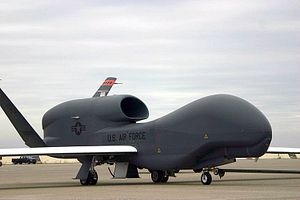With additional North Korean saber-rattling on Saturday and China pushing against its South China Sea boundaries last week, Japan and the U.S. have announced a plan to increase drone patrols over North Korea and the East China Sea starting later this month. The U.S. will deploy two Global Hawk unmanned aerial vehicles from Misawa Air Base in Aomori Prefecture, and the Japanese Air Self-Defense Forces plans to acquire three of those same UAVs from 2015. While the Japanese procurement and the stationing of both countries UAVs in Misawa have been known since January this year, regional tensions have prompted officials to be more vocal about their intended use. A senior Self-Defense Force official said the drones, “will be effective in surveying the activities of North Korea and the Chinese military.”
North Korea has been threatening a new round of nuclear tests since March, and on Saturday through its official KCNA news agency stated, “it would take counter-measures including nuclear test to protect the sovereignty and dignity (of North Korea).” Another official paper, the Rodong Sinmun, said the country was justified in using all available means to counter aggressive challenges from the U.S. and South Korea.
Last week, China was at the center of a significant increase in tensions in the South China Sea in two separate events: the ramming of Vietnamese vessels as China sought to install an offshore oil rig near the Paracel Islands and the apprehension of a Chinese fishing vessel near the Half Moon Shoal by the Philippines, both in disputed territorial waters. Japan was particularly vocal in its response to China’s actions, saying it was strongly concerned about the increase in tension due to “China’s unilateral exploration.”
Given the recent regional context, it’s not surprising that the U.S. and Japan would seek to increase the public profile of their military assets, and to underscore their ability to keep an eye on neighboring states should they choose to posture their assets in a threatening manner. However, given the ongoing dispute between Japan and China over the Senkaku/Diaoyu Islands in the East China Sea, basing the new UAVs at the far northern facility of Misawa is curious. Situating the new drones in Okinawa would seem to make more sense, giving Japan and the U.S. increased surveillance capabilities over the South China Sea while still allowing them to cover North Korea.
Deployment of the UAVs to Misawa could possibly be a sop to the local Japanese population in Okinawa. Given the radius of the Global Hawk drones (8,700 miles/14,000 km), basing out of Misawa still allows for extended coverage of both North Korea and the East China Sea. The Misawa Air Base is also a much less contentious installation, with the local population much more amenable to the U.S. presence (despite recent low-level protests). The Japanese government is also playing up the ability of the new Global Hawk drones to help provide data about the reactors at its crippled Fukushima No. 1 nuclear power plant. Basing the drones at the (relatively) nearby Misawa Air Base will likely make the purchase less controversial domestically.
The UAVs don’t represent a significant shift in surveillance capabilities in the region. Both the U.S. and Japan use satellite imagery to keep track of North Korea’s nuclear development, and China has little interest in keeping its naval maneuvers around the Senkaku/Diaoyu Islands a secret. However, the drones do reinforce the relationship of shared military technology between the U.S. and Japan, and in a segment (high-altitude, long-range drones) where the U.S. enjoys a significant developmental edge over others in the region. It is an easy way to show solidarity with the Japanese, and thus plays into their shared strategy of countering real and perceived aggression from China and North Korea.
If Japan and the U.S. decide to use these new UAVs in a provocative manner, such as openly operating them in violation of Chinese or North Korean airspace, that would constitute a real change. For North Korea, the drones provide little more than redundancy in the system used to maintain surveillance of its nuclear facilities. It is in regard to China that these UAVs, particularly for Japan, represent an improved level of sophistication in maintaining consistent coverage of Chinese naval assets in the East China Sea. The Chinese know this as well, but it remains to be seen if the deployment will have any effect on either country’s behavior.

































